 J Clin Aesthet Dermatol. 2021;14(3):E58–E62.
J Clin Aesthet Dermatol. 2021;14(3):E58–E62.
by Tsioumas G. Sotiris, MD; Giulio Nittari, PhD; Getu Gamo Sagaro, Phd; and Francesco Amenta, MD
Dr. Sotiris is with the Tsioumas Sotiris Clinic in Athens, Greece. Drs. Nittari, Sagaro, and Amenta are with the School of Medicinal and Health Products Sciences at the University of Camerino in Camerino, Italy. Dr. Amenta is also with the Research Department at the International Radio Medical Center (C.I.R.M.) in Rome, Italy.
FUNDING: No funding was provided for this article.
DISCLOSURES: The authors report no conflicts of interest relevant to the content of this article.
ABSTRACT: Background: Plasma exeresis is an aesthetic procedure used for the non-surgical treatment of a variety of skin problems. This technology allows for the improvement of skin imperfections and wrinkles and can be used to treat certain dermatological disorders.
Objective: The purpose of this descriptive study was to describe the demographics and postprocedural recovery experiences of patients who underwent plasma exeresis at a single clinic over a period of eight months. Additionally, data on patient satisfaction with the treatment was recorded.
Methods: A descriptive, cross-sectional study was conducted. Participants in the study included all individuals who underwent plasma exeresis at the Tsioumas Clinic in Greece over a period of eight months from September 2018 to April 2019. Frequency distribution tables were used to describe the types of cases and the number of patients who underwent plasma exeresis treatment each month.
Results: A total of 710 patients underwent plasma exeresis within 124 actual working days during the study period. Of these, 73.4% (n=528) were women, and 25.6% (n=182) were men. The most cases were recorded in January, March, November, and February, representing 15.5 percent, 15.4 percent, 15 percent, and 14 percent of the total cases, respectively. Over 33 percent and 18 percent of patients were treated in the upper and lower eyelids, respectively. With regard to patient satisfaction, more than 52.9 percent of the patients reported being extremely satisfied with the plasma exeresis treatment.
Conclusion: The results from our study demonstrate that plasma exeresis is most popular in our clinic from November to March, and the upper and lower eyelids were the most frequently treated areas during the eight-month study period. While not all patients who were originally treated were able to be reached to report their level of satisfaction, the majority of the proportion of patients that were able to be contacted reported being satisfied with the treatment. Future research with more objective efficacy measurements are needed to support our findings.
Key words: Plasma exeresis, aesthetic dermatology, wrinkles
Plasma exeresis is an aesthetic procedure used for the non-surgical treatment of a variety of skin problems. It works by ionizing the gases in the space between the instrument’s tip (i.e., sprayer) and the tissue being treated.1
The plasma exeresis device is a hand-operated, cordless microsurgical device that transfers concentrated heat to the skin tissues being treated. It uses the voltage difference to generate a small electric arc and does not work if kept in direct contact with the tissue being treated. The electric arc causes the sublimation of fluids in the skin’s superficial part, without unwanted heat transmission to the adjacent tissues. The plasma sublimates the epidermis but does not cross the basement membrane of the skin.2
This technology allows for the improvement of skin imperfections and wrinkles and can be used in the treatment of certain dermatological disorders, such as acne.3 Plasma exeresis has been suggested as a less invasive alternative to blepharoplasty with less down time and limited side effects.3,4 Plasma exeresis can be combined with other treatments, including autologous threads, mesotherapy, and platelet-rich plasma.5 Additionally, plasma exeresis offers desirable outcomes at an affordable cost.2,6 According to histological analyses performed by Sotiris et al,6 it is suggested that collagen type 3 may be produced after a certain length of time following the application of plasma exeresis.
The purpose of this descriptive study was to analyze the demographics of patients who underwent plasma exeresis at a single clinic in Athens, Greece for eight months. Additionally, data on patient satisfaction with the treatment was recorded.
Methods
This was a descriptive, cross-sectional study was conducted. The study participants included all individuals who underwent plasma exeresis at Tsioumas Clinic in Greece for eight months from September 2018 to April 2019. Data were collected by clinical staff who are working at the clinic. We considered patients who underwent plasma exeresis treatment in one or more areas. However, factors including age, sex, previous treatments, and case complexity were not considered. Specific areas and conditions treated by plasma exeresis, post-procedure recovery, and patient satisfaction level were considered in this study. Patient satisfaction was measured via subjective patient satisfaction questionnaire. Patients rated their satisfaction based on a five-point scale, as follows: 1) a little satisfied; 2) satisfied enough; 3) much satisfied; 4) very much satisfied; and 5) extremely satisfied. Regarding patient recovery, this was evaluated based on the duration of the treated area’s ruddiness and crust generation. Frequency distribution tables were used to describe the types of cases and the number of patients who underwent plasma exeresis treatment per month.
Results
Patients. During the eight months from September 2018 to April 2019, 710 patients underwent plasma exeresis within 124 actual working days. The clinic operates approximately 22 days per month according to the guidelines of Greek law. The actual number of working days when the doctor was on duty and the number of cases per month over these eight months is shown in Table 1. The greatest number of patients were treated in January, March, November, and February, representing 15.5, 15.4, 15, and 14 percent of the total cases, respectively. On the other hand, the lowest number of patients were treated in September (7.5% of the total cases) and October (9.6% of the total cases) (Table 1).

Figure 1 illustrates the monthly frequency of patients by sex during the study period; 73.4 percent of patients (n=528) were female, and 25.6 percent (n=182) were male. A greater number of female patients were treated in November, January, and March, whereas a greater number of male patients were treated in November and December (Figure 1).
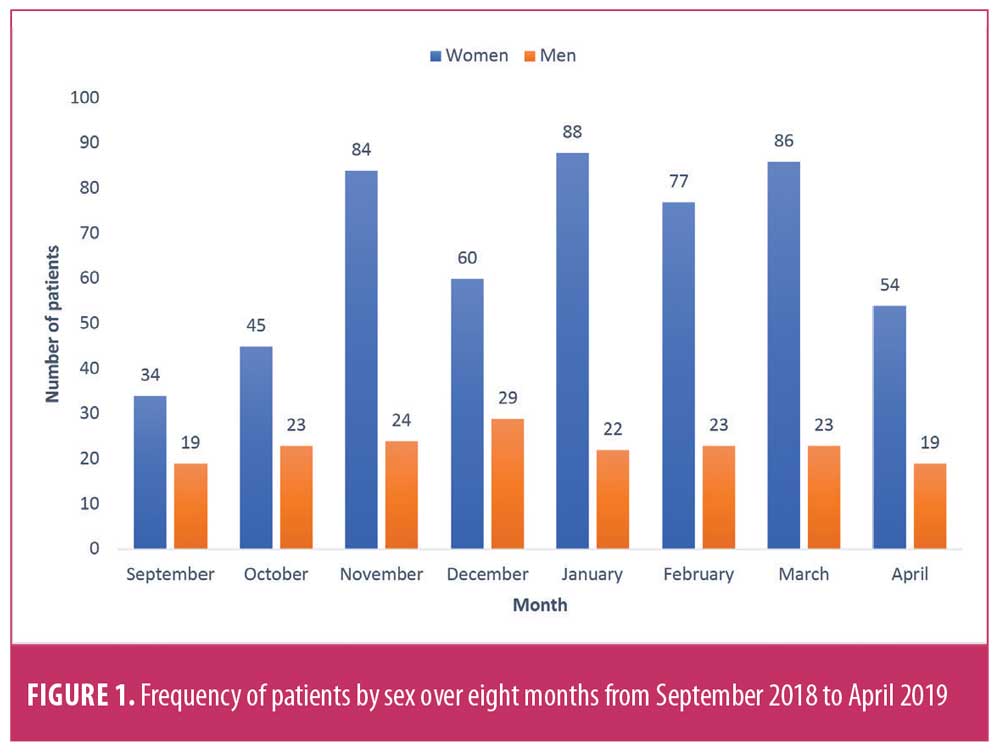
Types of cases. Table 2 shows the types of cases and number and percentage of cases over the study period. Accordingly, out of 710 cases, about 33 and 18 percent of patients were treated in the upper and lower eyelids, respectively. A greater number of upper eyelid cases were treated in September (n=47), January (n=40), and March (n=40), whereas a greater number of lower eyelid cases were treated in December (n=22) and January (n=23). Mouth and neck cases were the third and fourth frequently performed cases, accounting for 8.5 percent and 6 percent of the total cases, respectively. Twelve (1.7%) and nine (1.3%) patients were treated for acne scars and on the full face, respectively. Patients who were treated for hemangioma, stretch marks on the feet, or papilloma, or on the areola or nose were on the lower end of the spectrum, with 0.30% of equal rank. Only one patient (0.14%). Among the patients who underwent repeated sessions, 88 percent were women, and 12 percent were men (Figure 2).
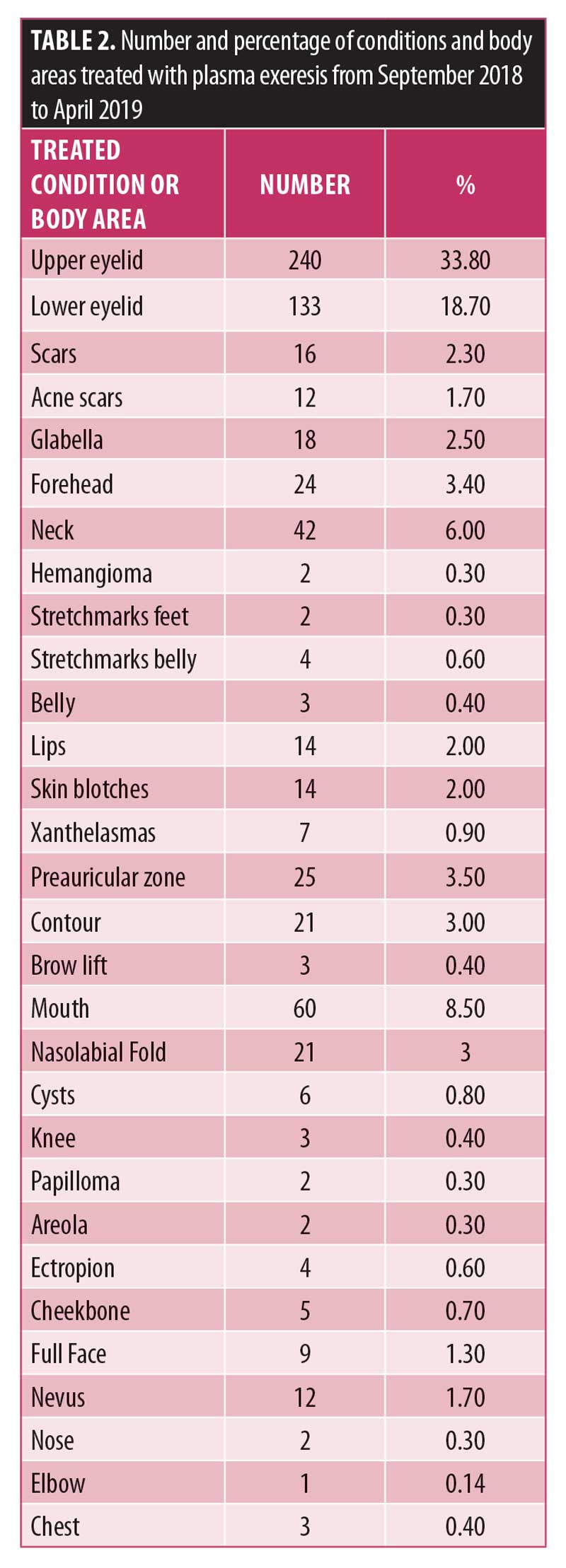
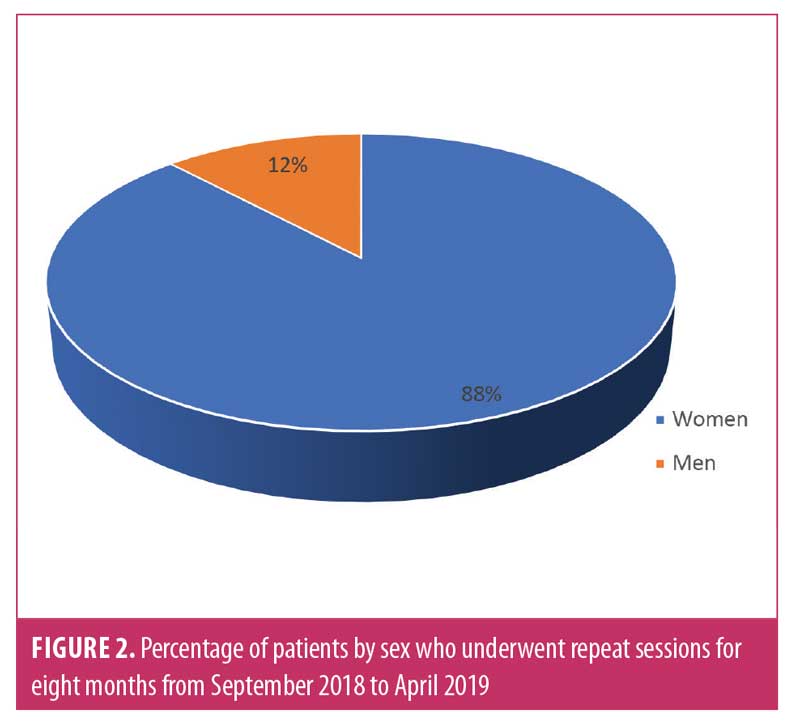
Recovery. Patient recovery was evaluated subjectively by the clinic staff. In obtaining patient feedback, the clinical staff was not able to reach everyone, so the evidence is based only on respondents. The average time required for full recovery after plasma exeresis treatment was approximately one and a half months for men. In the days following the procedure, a crust forms over the treated area; this crust usually resolves within a week, leaving behind a ruddiness that continues to resolve over time. In our experience, it is rare that this reddish-pink discoloration persists for more than two or three months. Figure 2 shows the recovery data of male patients who received plasma exeresis treatment. In the first two months, 37 out of 182 male patients had fully recovered, 20 patients displayed light pink ruddiness in the treatment area, 27 patients displayed a darker pink color. Seven male patients experienced an extensive crust generation for seven days, and seven male patients experienced crusting that persisted for longer than seven days. Twelve patients did not provide details regarding their recovery (Figure 3).
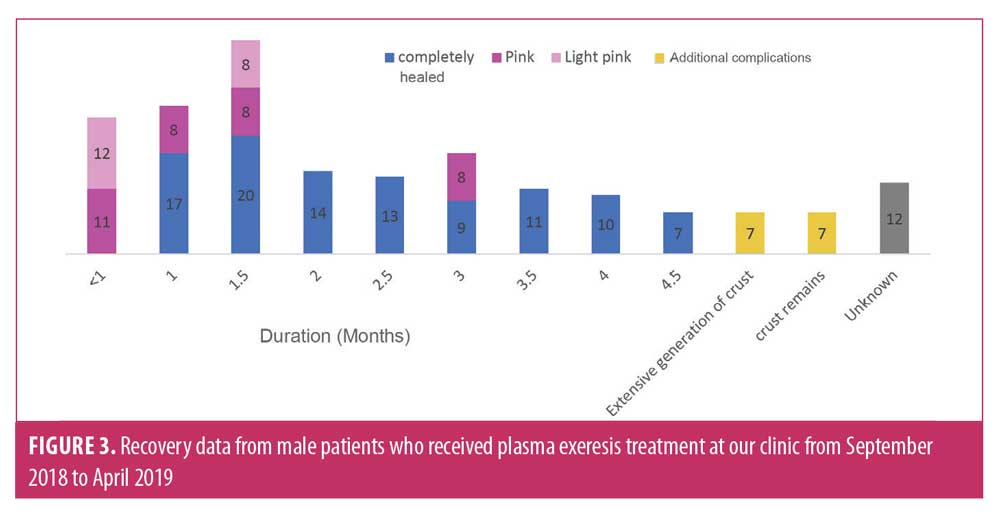
Regarding female patients, it should be noted that, as a result of applying foundation to the treated area, the clinical staff also observed a brown coloration in the treated area in addition to pink and light pink. The average time required for full recovery in female patients was two to two and a half months. Of 528 female patients, 183 (34.5%) displayed neither crusts nor ruddiness, and the treated areas were completely healed; 20.3%(107) of patients developed a pink ruddiness. Extensive crusting was not observed in and female patients. There were 12 female patients in which crusting persisted for longer than 10 days following the procedure (Figure 4).
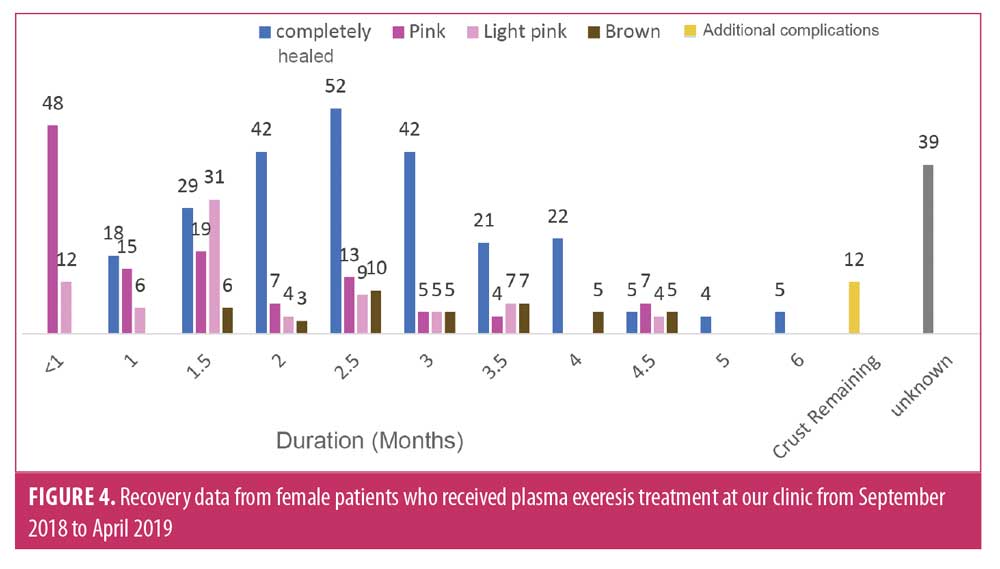
Patient satisfaction. Of 710 patients, 152 (21.4%) were not able to be reached to assess satisfaction; 558 patients were evaluated for satisfaction. Of these 558, 295 (52.9%) reported being “extremely satisfied” with the plasma exeresis treatment; 35.5% of the patients responded that they were “very much satisfied” with the treatment. Nearly five percent of patients rated their level of satisfaction as “much satisfied” and nearly six percent of respondents rated their satisfaction as either “a little satisfied” or “satisfied enough.”
Out of the total 710 patients who originally underwent a plasma exeresis procedure, 319 subjects remained in contact with the clinic and again underwent the plasma exeresis procedure. Figure 5 illustrates the number of patients who underwent plasma exeresis in one or more than one areas from September 2018 to April 2019.

Discussion
This descriptive cross-sectional study on the application of plasma exeresis recorded the number of patients who underwent plasma exeresis treatment, recovery details of these patients, level of patient satisfaction with the treatment, and the number of patients who underwent plasma exeresis in one or more areas from September 2018 to April 2019. In total, 710 patients underwent plasma exeresis over the study period.
As reported in Table 1, from November to March, an increase in the number of plasma exeresis treatments performed was observed. In our clinical experience, requests in general for aesthetic treatments increase in November and February. For non-aesthetic treatments, the demand remains stable throughout the year. We do not advise plasma exeresis to be done in the summer months in Greece, especially in patients with fairer skin types, due to the increased sun exposure during these months.
Our results reported that roughly 33 percent and 18 percent of patients were treated in the upper and lower eyelids, respectively. Another article from the lead author on the present paper stated that conventional blepharoplasty impedes on the normal life of patients due to a long and frequently painful recovery process.6 For that reason, alternatives like plasma exeresis have been evaluated for their advantages over conventional blepharoplasty, with the main advantage being decreased down time. Plasma exeresis has also been suggested to be a possible alternative for facial lifting procedures.5,7–12
Despite the high demand for upper and lower eyelid treatment with plasma exeresis, we have also applied the procedure on bodily sites other than the face, including the knee, feet, elbow, and chest, among others.
Regarding recovery, the average time required for full recovery in male patients after plasma exeresis treatment is approximately one and a half months. In contrast, female patients require, on average, two to two and a half months to fully recover. Scrubbing, excessive use of body and/or face products, and improper handling of the treatment area can impede healing of the area post-procedure. In our clinical experience, one of the most common temporary effects of plasma exeresis is crusting. The more complicated a plasma exeresis treatment is, the longer it takes to heal. Another factor that has an impact on the patient’s recovery is the mobility of a treated area. For instance, the application of plasma exeresis on the eyelids is followed by a longer recovery period because of the constant motion of the eyelid. Generally, the time needed for crusting to resolve is approximately seven days. In our experience, some patients see a quicker resolution (1 to 4 days), but the majority see resolution in 7 to 10 days. The duration of the light pink to pink ruddiness that is observed following resolution of crusting varies, and depends upon factors such as patient aftercare, the patient’s general health, the area’s mobility, and age.
Gauging patient satisfaction with a treatment is a crucial step towards improving care quality.13 Patient expectations before undergoing a procedure may significantly impact their perception regarding the treatment result.14 It is the practitioner’s responsibility to provide explicit information to their patients at this stage to avoid any unrealistic expectations. Our study found that over 88 percent of the patients were either “extremely satisfied” or “very much satisfied” by the service provided. This finding is in line with other studies conducted on plasma exeresis.2,3,4,15
Limitations. Our study was limited by the short duration of the study period. Additionally, in the present study, the efficacy of the plasma exeresis procedure was measured solely through subjective patient satisfaction responses and was not measured using any objective measurements. Future studies using objective measurement scales are needed to further support the efficacy of plasma exeresis for many of the applications discussed here.
Conclusion
The results from our study demonstrate that plasma exeresis is most popular in our clinic from November to March, and the upper and lower eyelids were the most frequently treated areas during the eight-month study period. While not all patients who were originally treated were able to be reached to report their level of satisfaction, the majority of the proportion of patients that were able to be contacted reported being satisfied with the treatment. Future research with more objective efficacy measurements are needed to confirm our findings.
References
- Rossi E, Farnetani F, Pellacani G. Applications of plasma exeresis in dermatology. Hi-Tech Dermo. 2016;2:17–22.
- Gloustianou G, Sifaki M, Tsioumas SG, Scarano A. Presentation Of Old And New Histological Results After Plasma Exercises (Plexr) Application (Regeneration Of The Skin Tissue With Collagen III). Pinnacle Med Med Sci. 2016;3(3):983–990.
- Stamatina G, Sotiris T, Aglaia V. Plexr In Acne Treatment. Pinnacle Med Med Sci. 2015;2(1): 1–5.
- Sotiris TG, Nikolaos G, Irini G. Plexr: The Revolution In Blepharoplasty. Pinnacle Med Med Sci. 2014;1(5):423–427.
- Sotiris TG. Combination of Autologous Treatments for Non-Invasive Blepharoplasty and Non-Surgical Full Face Lift. J Clin Exp Dermatol Res. 2017;8(5):1–5.
- Sotiris TG, Nikolaos G, et al. New Treatment with Plasma Exeresis for Non-Surgical Blepharoplasty. EC Ophthalmology. 2017;4:156–9.
- Fathi R, Pfeiffer ML, Tsoukas M. Minimally invasive eyelid care in dermatology: Medical, laser, and cosmetic therapies. Clin Dermatol [Internet]. 2015;33(2):207–16. Available from: http://dx.doi.org/10.1016/j.clindermatol.2014.10.012
- Rossi E, Farnetani F, Trakatelli M, et al. Clinical and confocal microscopy study of plasma exeresis for nonsurgical blepharoplasty of the upper eyelid: A pilot study. Dermatologic Surg. 2018;44(2):1–8.
- Rossi E, Paganelli A, Mandel VD, Pellacani G. Plasma exeresis treatment for epidermoid cysts: A minimal scarring technique. Dermatologic Surg. 2018;44(12):1509–15.
- Nipshagen MD, Velthuis PJ, Mosmuller DGM. Periorbital postinflammatory hyperpigmentation after plasma exeresis. Dermatol Ther. 2020;33(3):4–5.
- Paganelli A, Mandel VD, Pellacani G, Rossi E. Synergic effect of plasma exeresis and non-cross-linked low and high molecular weight hyaluronic acid to improve neck skin laxities. J Cosmet Dermatol. 2020;19(1):55–60.
- Rossi E, Paganelli A, Mandel VD, Pellacani G. Favre–Racouchot syndrome: report of a case treated by plasma exeresis. J Eur Acad Dermatology Venereol. 2018;32(11):e411–3.
- Sagaro GG, Yalew AW, Koyira MM. Patients’ Satisfaction and Associated Factors Among Outpatient Department at Wolaita Sodo University Teaching Hospital, Southern Ethiopia: A Cross Sectional Study. Sci J Clin Med. 2015;4(5):109.
- CEN. Aesthetic medicine European standards: non-surgical medical treatment, 2017 [Internet]. https://www.laingbuissonnews.com/imtj/european-standards-on-non-surgical-medical-procedures-implemented/. Accessed November 25, 2020.
- Sotirios TG and Nantia S. Non Invasive Blepharoplasty with Plasma Exeresis (Plexr) Pre/Post Treatments. J Aesthetic Reconstr Surg. 2018;04(01):1–4

